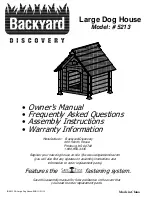
premierpet.com
13
Turning the boundary width control knob clockwise increases the
boundary width while turning it counterclockwise decreases it (
6D
).
Repeat this activity as needed until the receiver collar tones between 6 to
10 ft. from the boundary wire. If using a double loop layout, you may need
to increase the separation of the boundary wire and/or increase the size
of the boundary width to achieve the desired range.
6. Test in a number of different locations around the containment area until
you are satisfied that the system is functioning properly.
7. Next, walk all around the pet area to ensure there are no areas where
the receiver collar may activate from signals coupled onto buried wires
or cables. Test the collar in and around the inside of the house as well.
As mentioned, cable and wires from cable TV, electrical or telephone
lines may conduct pet fencing signals inside and outside the house that
can activate the dog’s collar accidentally. While rare, if this occurs your
boundary wire is probably too close to these outside lines and should be
moved or modified as shown in Figure 3A.
8. To test the run-through prevention feature, walk towards the boundary
wire. The receiver collar should tone and the test light should flash
brighter as you enter the run-through area (
6E
). If you are satisfied that
your system is functioning properly, you are ready to start burying the
boundary wire. If the receiver collar did not tone or the test light did not
flash, see the “Troubleshooting” section.
Install the Boundary Wire
To Bury the Boundary Wire
Before you begin installing the boundary wire, unplug the fence transmitter power adapter from the outlet.
Burying the boundary wire is recommended to protect it and prevent disabling the system.
1. Cut a trench 1–3 in. deep along your planned boundary.
2. Place the boundary wire into the trench maintaining some slack to allow
it to expand and contract with temperature variations.
3. Use a blunt tool such as a wooden paint stick to push the boundary wire
into the trench. Be careful not to damage the boundary wire.
To Attach the Boundary Wire to an Existing Fence
The boundary wire of the Premier Pet
™
In-Ground Fence
™
system can be
attached to a chain link fence, split rail fence, or a wooden privacy fence.
The boundary wire can be attached as high as needed. However, make sure
the boundary width is set at a high enough range for the pet to receive the
signal. If using a double loop with an existing fence at least 5 ft. tall, run the
boundary wire on top of the fence and return it on the bottom of the fence to
get the 3 to 5 ft. separation needed.
• Chain Link Fence (7A):
Weave boundary wire through the links or use
plastic quick ties.
•
Wooden Split Rail or Privacy Fence (
7A
): Use staples to attach boundary
wire. Avoid puncturing the insulation of the boundary wire.
• Double Loop with an Existing Fence:
Run the boundary wire on top
of the fence and return it on the bottom of the fence to get the 3 to 5 ft.
separation needed.
• Gate (Single Loop) (7B):
Bury the boundary wire in the ground across the
gate opening.
Note: The signal is still active across the gate. Your pet cannot
pass through an open gate.
• Gate (Double Loop) (7B):
Bury both boundary wires across the gate
opening while keeping them at least 5 ft. apart.
6D
Boundary
Wire
6E
7A
DOUBLE LOOP
SINGLE LOOP
5'
5'
7B










































